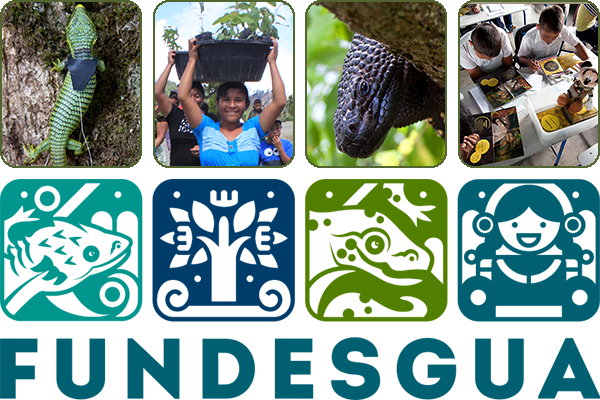
FUNDESGUA, the Foundation for the Endangered Species of Guatemala, works in partnership with the International Reptile Conservation Foundation for the conservation of endangered Guatemalan species and ecosystems. Our work targets species that have been neglected by other conservation groups or government institutions that have traditionally focused on more widespread ecosystems and large, well known, species.
We have found Guatemalan endemic reptiles as one of the most endangered and unprotected species groups. Naturally restricted distributions along with persecution, habitat destruction and complete absence of conservation action have put many Guatemalan reptile species in critical danger of extinction. We strive for the protection of these through a comprehensive approach involving applied research, direct habitat conservation, social programs and conservation education.
To date, our main target species are the Guatemalan beaded lizard and its associated ecosystem, and the arboreal alligator lizards of the genus Abronia, with eight endemic species in the country.
Conservation Abronia and Conservation Heloderma work to protect the severely endangered Campbell’s Alligator Lizard (Abronia campbelli) of eastern Guatemala’s pine-oak forests and the surviving thornscrub and tropical dry forest habitat of the Guatemalan Beaded Lizard (a mere 42,000 acres); considered in the classification developed by the World Wildlife Fund (Dinerstein et to. 1995) to be an ecoregion of special concern based on the singularity of its biota. Isolated on all sides by massive cloud-forested mountains and rainforest valleys, the Beaded Lizards have evidently existed in total isolation in this tiny island of desert habitat for many thousands of years.
Both of these lizards are threatened by deforestation and degradation of their habitat, persecution by the local community due to the belief that they are venomous as well as illegal collection for the international pet trade. Campbell’s alligator lizard is listed as critically endangered by the IUCN red list and the Guatemalan beaded lizard is a CITES I species. Our studies have shown that there may be as few as 2,500 alligator lizards and 300 beaded lizards left in the wild.
Species and Research
Conservation Abronia and Conservation Heloderma combine field research with habitat protection and restoration, captive breeding, community development, and a comprehensive program of environmental education within the natural range of Campbell’s alligator lizard in order to help preserve these unique animals.
The Abronia Center:
The Abronia Home started with a few individual alligator lizards housed in adequate but small enclosures, and utilized for education presentations and for studies to learn more about the basic husbandry methods necessary for these animals. The Abronia home was completed in 2014 and is located on the grounds of a disadvantaged children’s home. The property was donated by the facility and the site was originally used for garbage storage- it is a nice outcome that we repurposed a garbage dump into a conservation education area. The Abronia Home evolved into a breeding, head-start, training and educational vehicle for Conservation Abronia and the conservation of alligator lizards.
Reforestration Program:
To date project partners have germinated and planted more than 20,000 oak trees (the only trees that Campbell’s alligator utilizes as habitat) on 8 private farms along a 5-mile extent of riparian habitat that will ultimately connect with patches of intact forest on each farm. This huge reforestation project has been supported by each farm owner and the trees have been planted with over 10,000 hours of local community, volunteer help. In addition, we have created the first two for 12 community managed forests that will be utilized for the collection of wood for cooking of food and for the heating of homes. Each managed forest is approximately 25 acres and planted with 10,000 fast growing tree species. The first forest will be ready for wood harvest in 2018.
Educational Program:
The educational program has brought the conservation awareness message to more than 90.000 school children and teachers and will to over 4,000 children in 2017 in our two main conservation sites.
Scholarship program:
The project partners have implemented a scholarship program in order to help and to make sure that all the school children in our conservation sites can graduate high school. The evidence is clear that graduation from high school is critical to these young people being able to secure work outside subsistence agriculture. This is one of the single most important ways to help reduce habitat destruction through deforestation. To date we have 175 school children in the scholarship program.
Casa Program: House Construction
As part of our community development arm of the projects we have constructed 5 homes for the poorest of the poor in our conservation areas. The construction company, materials and labor force is all local to each community and thus serves as a substantial economic input to the area. So far, all the families that have received homes have put in many hours of sweat equity and have galvanized the community to our conservation efforts.
![]()
As part of our expanding conservation efforts in Guatemala that are saving species through land preservation, education, and support from local communities, Conservation Abronia and Conservation Heloderma needs our support. We encourage everyone to consider making a small donation to help make these programs even more successful.




 Member: IUCN, Species Survival Commission, Iguana Specialist Group
Member: IUCN, Species Survival Commission, Iguana Specialist Group